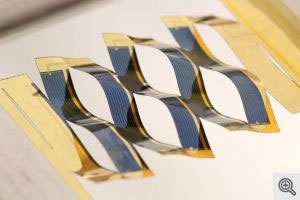Now that solar has gone mainstream, we can barely imagine the innovative designs we’ll see in coming years that make it ubiquitous. Here are few we’ve noticed lately.
Twisted Solar Cells
Since solar manufacturers have been making ground-mounted solar panels that track the sun, they have become much more efficient.
A new twist on that literally allows them to change shape as they track the sun.
Researchers at University of Michigan have found that solar cells can also track the sun by adhering them to a thin plastic membrane, where they can be stretched and turned for optimum absorption. The configuration is slipped into glass for mounting, making tracking solar panels possible for roofs.
By eliminating motors, they are much lighter and more cost-effective, making them useful for pitched rooftops and even vehicles.

"The beauty of our design is, from the standpoint of the person who’s putting this panel up, nothing really changes. But inside, it would be doing something remarkable on a tiny scale: the solar cell would split into tiny segments that would follow the position of the sun in unison," explains Max Shtein, Associate Professor of Materials Science and Engineering.
Tests show the "kirigami panel" generates 36% more energy than conventional solar panels, and slightly less than motorized trackers at 40%.
Other innovations along these lines are Spray-On Solar, which can be used on existing surfaces, thin glass that stores energy and solar cells made from carbon.
Solar Glass
At nearby Michigan State University, researchers have developed a solar collector that is so transparent that it can replace window glass.

That makes it possible for any transparent surface can generate solar electricity – windows, vehicles, even your smart phone.
The team uses small organic molecules to absorb specific nonvisible wavelengths of sunlight. "Because the materials do not absorb or emit light in the visible spectrum, they look exceptionally transparent to the human eye," says Richard Lunt, Engineering Professor.
He explains:
"We can tune these materials to pick up just the ultraviolet and the near infrared wavelengths that then ‘glow’ at another wavelength in the infrared. The "glowing" infrared light is guided to the edge of the plastic where it is converted to electricity by thin strips of solar PV cells.
"Ultimately we want to make solar harvesting surfaces that you do not even know are there."
Currently, solar conversion efficiency is only about 1% – their goal is to get it beyond 5%.
Solar Tulips
Another innovation makes solar concentrating towers possible on a community-scale level, rather than the enormous plants we see today.

Shaped like a tulip, AORA’s solar tower is surrounded by a small field of collectors. The 100 kilowatt (kW) modular array can easily be scaled for larger installations, connected to the grid or not. And it can be used with any fuel source, incorporating biogas, for example, for 24/7 electricity.
Besides electricity, the tulip produces 175 kW of thermal energy, used for heating, hot air and water.
And unlike solar concentrators that use steam to drive large turbines, the tuliip uses just 8% of the water because it uses hot air to power microturbines.
Mobile solar is another innovation for off-grid solar, to help people recovering from a disaster, off-grid hospitals and the military.

